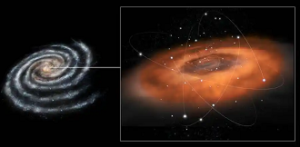
Terrestrial identity and the black hole
Chapter 2 of Edgar Morin’s book is “The Terrestrial Identity Card” where he states that after the discoveries of astrophysics, biology, paleontology, ideas about the life of the universe, the nature of the Earth and man’s own life were “subverted in the 1950s-1970s” and we still didn’t have James Webb and the discovery of the ties between homo sapiens and Neanderthals.
Terrestrial Identity Card” where he states that after the discoveries of astrophysics, biology, paleontology, ideas about the life of the universe, the nature of the Earth and man’s own life were “subverted in the 1950s-1970s” and we still didn’t have James Webb and the discovery of the ties between homo sapiens and Neanderthals.
“Afterwards, with Copernicus, Kepler, Galileo, the Earth stopped being the center of the universe and became a round planet around the Sun, like the other planets” (page 43) and seemed to “witness the perfection of its divine creator” for order and regularity, until an expanding universe was discovered based on Hubble’s observations of the separation of stars in 1923, the astrophysicist would later give his name to the famous telescope already surpassed by James Web.
At the beginning of the 19th century, “Laplace expelled the Creator God from a self-sufficient universe that had become a perfect machine for all eternity” (pg. 44) and not cited there, but also in a Mathematics Conference at the beginning of the 19th century. . XX Hilbert proposes some last problems not solved by mathematics, to say that everything is logical and mathematical.
In 1965, Arno Penzias and Harold Wilson would give facts for this expansion of the universe as an “isotropic radiation originating from all horizons of the universe” and this “cosmological background noise” a kind of “fossil residue” from the initial deflagration of the initial explosion that would confirm the famous Big Bang theory, today the new data casts doubt on this, but something remained from this period, which is the conception of anti-matter and the investigation of black holes.
The 1960s, when Penzias and Wilson won a Nobel Prize, would bring new celestial bodies among them: “quasars (1963), pulsars (1968) (pg. 44), then black holes, and astrophysicists’ calculations suggest that we only know 10% of the matter, 90% of which is still invisible to our detection instruments” and that James Web is only now looking at.
The center of our galaxy is no longer the sun, but a black hole, and in it unfolds a whole new vision of the universe as “in its beginning the Unknown, the Unfathomable and the Inconceivable” (pg. 44), here we are now in a galaxy 8 billion years after “the birth of the world, and which, with its neighbors, seems attracted to a huge invisible mass called the “great Attractor” “ (idem), which is a black hole.
And we, a small planet, created 4 billion years ago, discover that it has a history, “and takes shape in the 19th century” and on the threshold of the 20th century, the German Alfred Wegener elaborates the theory of continental drift, despite the initial resistance, proven later.
After its initial long periods of cooling, the formation of the first microorganisms, and finally man appears, “the last and deviant branch of the tree of life, appears within the biosphere, which, linking ecosystems to ecosystems, now involves the entire planet”, This early birth, in recent discovery also unites Neanderthals and homo sapiens.
If “Bacon, Descartes, Buffon, Marx make it their mission to dominate nature and reign over the universe” (pg. 54), “from Rousseau onwards, romanticism will umbilically link the human being to Mother Nature” and thus, having a mother, man can be born and inhabit this Mother Earth.
MORIN, E. and Kern, A.B. Terra-Pátria. Trans. by Paulo Azevedo Neves da Silva. Brazil, Porto Alegre: Sulina, 2003.









